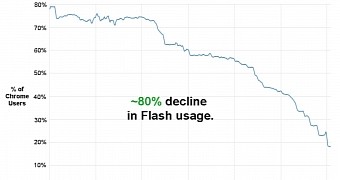After Adobe's big announcement this morning that they plan to end support for Flash in late 2020, Google Chrome's Anthony Laforge published a blog article asking Flash developers to start transitioning to HTML.
For a long time, Google shipped its Chrome web browser built-in with Flash support, but it now looks like Chrome will slowly start blocking Flash content, require explicit permission from users, until upstream support is terminated three years from now, at the end of 2020. Google, like anyone else on this planet, believe HTML is faster, safer, and more power efficient than Flash, without a doubt.
"Flash helped make the web a rich, dynamic experience, and shaped the modern set of web standards. We recognize that any transition can have challenges, but we will continue to work closely with Adobe and the web community to ensure that users have a great experience and to help developers make the web transition to HTML," said Anthony Laforge, on behalf of the Chrome team.
Flash usage has declined 80% in the last three years
According to Google, it would appear that Flash usage has declined 80% in the last three years, among users of the Chrome web browser on the desktop (Linux, Mac, and Windows), and now only 17% of Chrome users visit websites that still contain Flash content as developers transitioned to HTML. Google strongly encourages websites to start dropping any Flash content and replace it with HTML code.
Chrome, among many other popular web browser to follow, will start increasing the number of restrictions on Flash content in the coming months and years, up until Adobe will pull the plug. Therefore, it is recommended that web developers start exploring technologies like WebAssembly, switching to HTML ads, and read Mozilla’s media migration guide for replacing Flash multimedia content.

 14 DAY TRIAL //
14 DAY TRIAL //